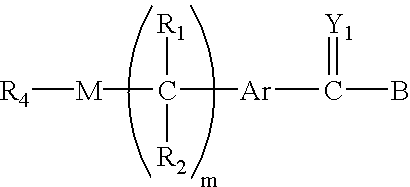Prodrugs of anticancer agents employing substituted aromatic acids
a technology of anticancer agents and aromatic acids, applied in the field of prodrugs, can solve the problems of bioactive materials, difficult solubility of alkaloids, and rapid degradation, and achieve the effect of modulating the hydrolysis ra
- Summary
- Abstract
- Description
- Claims
- Application Information
AI Technical Summary
Benefits of technology
Problems solved by technology
Method used
Image
Examples
example 1
PEG Aromatic Amides (3a and 3b).
[0079]A mixture of 2 (5.0 g, 0.125 mmol), 1a or 1b (0.496 mmol) in anhydrous pyridine (50 mL) was stirred at 45° C. overnight under argon atmosphere. The mixture was cooled to room temperature and concentrated in vacuo followed by the recrystallization from IPA (500 mL) to give 3a from 1a and 3b from 1b.
PEG 4-aminomethylbenzoic Acid (3a).
[0080]96% yield: 13C NMR δ 41.46, 66.91-70.71 (PEG), 126.57, 128.71, 129.22, 142.95, 166.75, 169.35.
PEG 4-aminobenzoic Acid (3b).
[0081]83% yield: 13C NMR δ 69.91-70.89 (PEG), 118.36, 126.67, 130.22, 140.64, 167.21, 167.94.
example 2
PEG Aromatic Amide Thiazolidinyl Thione Imide (5a and 5b).
[0082]A mixture of 3a or 3b (0.099 mmol), 2-mercaptothiazoline (4, 71 mg, 0.60 mmol), EDC-HCl (78 mg, 0.40 mmol), and DMAP (97 mg, 0.79 mmol) in anhydrous DCM (80 mL) was stirred overnight at room temperature. The mixture was concentrated in vacuo and the residue recrystallized from IPA to give 5a from 3a and 5b and 3b. The NMR confirmed the activation of the benzoic acid and the presence of 2-mercaptothiazoline in almost 1:1 ratio. These intermediates were used as is.
example 3
PEG Aromatic Spacer ara-C (6a and 6b).
[0083]A mixture of activated imide 5a or 5b (0.074 mmol), ara-C (108 mg, 0.44 mmol), and DMAP (72 mg, 0.59 mmol) in anhydrous pyridine (30 mL) was stirred overnight at 45° C. The mixture was concentrated in vacuo and the residue was recrystallized from IPA to give 6a from 5a and 6b from 5b. The amount of Ara-C present in this compound as measured by UV assay was given by weight %.
PEG ara-C 4-aminomethylbenzenamide (6a).
[0084]94% yield, 1.18% of ara-C present: 13C NMR δ 42.42, 59.59, 61.70, 62.22, 64.11, 67.51, 68.64, 69.30-73.16 (PEG), 74.30, 75.86, 77.57, 77.69, 82.21, 86.58, 88.48, 96.16, 128.02, 128.11, 129.13, 130.35, 1455.85, 147.55, 148.23, 170.73.
PEG ara-C 4-aminobenzenamide (6b).
[0085]90% yield, 1.03% of ara-C present: 13C NMR δ 65.21, 70.90-70.94 (PEG), 76.30, 78.86, 86.58, 88.48, 96.16, 118.15, 128.07, 128.24, 130.35, 145.85, 147.55, 148.23, 170.80.
PUM
| Property | Measurement | Unit |
|---|---|---|
| molecular weight | aaaaa | aaaaa |
| molecular weight | aaaaa | aaaaa |
| molecular weight | aaaaa | aaaaa |
Abstract
Description
Claims
Application Information
 Login to View More
Login to View More - R&D
- Intellectual Property
- Life Sciences
- Materials
- Tech Scout
- Unparalleled Data Quality
- Higher Quality Content
- 60% Fewer Hallucinations
Browse by: Latest US Patents, China's latest patents, Technical Efficacy Thesaurus, Application Domain, Technology Topic, Popular Technical Reports.
© 2025 PatSnap. All rights reserved.Legal|Privacy policy|Modern Slavery Act Transparency Statement|Sitemap|About US| Contact US: help@patsnap.com



